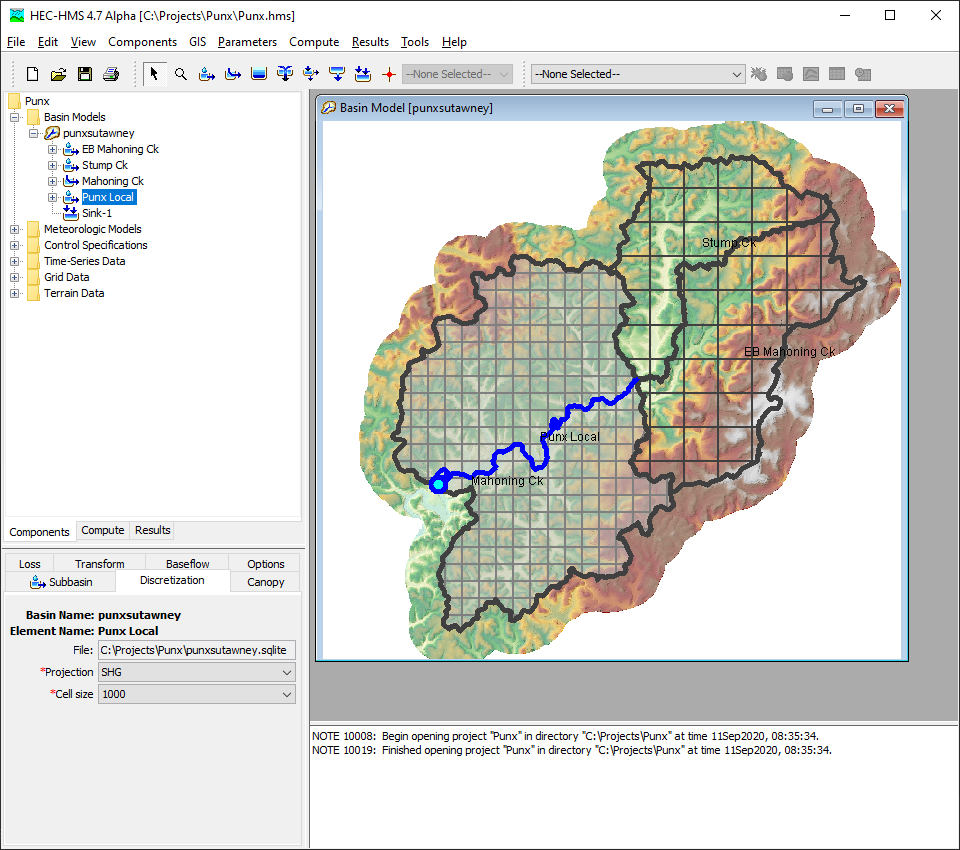HEC-HMS 4.7 is now available! The Hydrologic Modeling System (HEC-HMS) is designed to simulate the complete hydrologic processes of dendritic watershed systems. The software includes many traditional hydrologic analysis procedures such as event infiltration, unit hydrographs, and hydrologic routing. WMS has unparalleled tools that allow you to easily download and use spatial data for hydrologic modeling. After downloading the necessary data, you can use.
The official public website of the Hydrologic Engineering Center, U.S. Army Corps of Engineers
Keywords: Hydrologic Engineering Center, HEC, Institute for Water Resources, IWR , Army Corps, Engineers, USACE
For more information please visit: http://hec.usace.army.mil/software/

The Ecosystem Functions Model (HEC-EFM) is designed to help study teams determine ecosystem responses to changes in the flow regime of a river or connected wetland.
Hec Hms Download 4.2.1
The Flood Damage Reduction Analysis (HEC-FDA) software provides the capability to perform an integrated hydrologic engineering and economic analysis during the formulation and evaluation of flood risk management plans.
The HEC-FIA Flood Impact Analysis software package analyzes the consequences from a flood event.
The Hydrologic Modeling System (HEC-HMS) is designed to simulate the complete hydrologic processes of dendritic watershed systems.
HEC-RAS is designed to perform one-dimensional hydraulic calculations for a full network of natural and constructed channels.
HEC-ResPRM is a reservoir system operations optimization software package developed to assist planners, operators, and managers with reservoir operation planning and decision-making.
The Reservoir System Simulation (HEC-ResSim) software is used to model reservoir operations at one or more reservoirs for a variety of operational goals and constraints.
The Regime Prescription Tool (HEC-RPT) is designed to facilitate entry, viewing, and documentation of flow recommendations in real-time, public settings.
Statistical Software Package (HEC-SSP) developed by the Hydrologic Engineering Center. This software allows you to perform statistical analyses of hydrologic data.
Whew! I feel like I'm the first person to crack this HEC-HMS XSL Style Sheet nut. In any case I'm the first one to share it on the web.First of all, before diving into how to get a report using a Style Sheet, you should realize that a sort of basin model report from HEC-HMS is available as a readable text file in the .basin file. But beyond that, for the purposes and in the hope that we users would develop tabular reports, the HEC also provided a report definition language (that they didn't document very well) for reports we can get from the Tools, Reports menu.
I was able to create an SCS Basin Summary style sheet by using the 'tags' in the .basin file, making them lower case and removing spaces from them. Here's an example of how I added the Curve Number to my report:
1. The sample Snyder report provided by the HEC includes this snippet
2. My .basin file includes this snippet
3. I turned 'Curve Number' from step 2 into curvenumber below. I continued that way to use the example of the .basin file and correct (with some oddities) the table HTML to create an SCS Basin table as shown below:

 And here is the complete file I saved as SCSBasinSummary.xsl
And here is the complete file I saved as SCSBasinSummary.xslAnd here is the resulting report :-) :
Basin Model 'Bisbee Tailing 071609'
| Subbasin | Area | SCS CN | SCS Lag |
|---|---|---|---|
| SCTSA Top Basin | 0.2149 | 87 | 17.7 |
| SCTSA Top Pond 1 | 0.1548 | 87 | 24.1 |
| SCTSA Top Pond 2 | 0.1345 | 87 | 28.8 |
| SCTSA Top Pond 3 | 0.0877 | 87 | 24.7 |
| SCTSA TOE-1 | 0.0895 | 87 | 9.4 |
| W Natural Ground 1 | 0.0831 | 87 | 11.7 |
| SCTSA Main 2 WS | 0.01259 | 87 | 11.0 |
| SCTSA-W3 | 0.0079 | 87 | 3.2 |
| SCTSA-W1 | 0.0073 | 87 | 3.2 |
| SCTSA Main 3 WS | 0.0327 | 87 | 8.7 |
| HR 1 | 0.0168 | 87 | 1.5 |
| SCTSA-S3 | 0.0135 | 87 | 4.3 |
| SCTSA-S4 | 0.0125 | 87 | 4.1 |
| SCTSA-S2 | 0.0058 | 87 | 2.6 |
| SCTSA-S1 | 0.0053 | 87 | 2.3 |
| SCTSA-S5 | 0.0166 | 87 | 4.8 |
| SCTSA-S6 | 0.0132 | 87 | 3.2 |
| SCTSA-S7 | 0.0168 | 87 | 6.1 |
| HP-1 | 0.047 | 87 | 6.3 |
| SCTSA-S8 | 0.0217 | 87 | 5.3 |
| Upstream Natuural | 0.6291 | 87 | 15.3 |
| NCTSA Top | 0.2581 | 87 | 18 |
| NCTSA-E3 | 0.0289 | 87 | 5.3 |
| NCTSA-E5 | 0.0083 | 87 | 3.6 |
| NCTSA-E2 | 0.0050 | 87 | 3.8 |
| NCTSA-E1 | 0.0033 | 87 | 2.2 |
| NCTSA-E4 | 0.0022 | 87 | 2.9 |
| SCTSA-E3 | 0.0108 | 87 | 6.5 |
| NCTSA Main 4 WS | 0.0055 | 87 | 2.5 |
| NCTSA Main 5 WS | 0.0162 | 87 | 2.9 |
| SCTSA-E2 | 0.0123 | 87 | 5.7 |
| NCTSA Main 6 WS | 0.0097 | 87 | 4.2 |
| SCTSA-E1 | 0.0060 | 87 | 4.5 |
| NCTSA Main 7 WS | 0.0075 | 87 | 2 |
| SCTSA-E0 | 0.0022 | 87 | 2.9 |
| NCTSA Main 8 WS | 0.0057 | 87 | 1.9 |
| HR-2 | 0.0097 | 87 | 1.5 |
| HP-2 | 0.0475 | 87 | 3.9 |
| SCTSA-E4 | 0.0070 | 87 | 1.6 |
Here's another one that reports both SCS and Green-Ampt and Clark:
<table border='2' width='100%'>
Hec Hms Tutorial Download
<tr><th></th>
<th>Subbasin</th>
<th>Area</th>
<th>SCS CN</th>
<th>SCS Lag</th>
<th>GA IC</th>
<th>GA SC</th>
<th>GA Suction</th>
<th>GA Conduct.</th>
<th>GA %Imp.</th>
<th>Clark TC</th>
<th>Clark R</th>
</tr>
<xsl:for-each select='/HMS:basin/HMS:subbasin'>
<tr>
<td><xsl:apply-templates select='.'/></td>
<td><xsl:apply-templates select='./HMS:area'/></td>
<td><xsl:apply-templates select='./HMS:lossrate/HMS:curvenumber'/></td>
<td><xsl:apply-templates select='./HMS:transform/HMS:lag'/></td>
<td><xsl:apply-templates select='./HMS:lossrate/HMS:initialcontent'/></td>
<td><xsl:apply-templates select='./HMS:lossrate/HMS:saturatedcontent'/></td>
<td><xsl:apply-templates select='./HMS:lossrate/HMS:wettingfrontsuction'/></td>
<td><xsl:apply-templates select='./HMS:lossrate/HMS:hydraulicconductivity'/></td>
<td><xsl:apply-templates select='./HMS:lossrate/HMS:percentimpervious area'/></td>
<td><xsl:apply-templates select='./HMS:transform/HMS:timeofconcentration'/></td>
<td><xsl:apply-templates select='./HMS:transform/HMS:storagecoefficient'/></td>
</tr>
</xsl:for-each>

</table>
